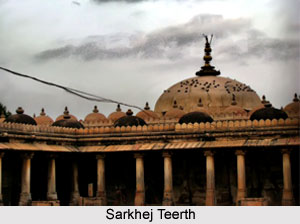 Sarkhej Teerth located in the Indian state of Gujarat is a Jain pilgrimage centre. The sacred place is situated in Sarkhej at a distance of almost eight kms from Ahmedabad. The temple is dedicated to Lord Vasupujya Swami, the twelfth Jain Tirthankara. It is a Siddha Kshetra.
Sarkhej Teerth located in the Indian state of Gujarat is a Jain pilgrimage centre. The sacred place is situated in Sarkhej at a distance of almost eight kms from Ahmedabad. The temple is dedicated to Lord Vasupujya Swami, the twelfth Jain Tirthankara. It is a Siddha Kshetra.
History of Sarkhej Teerth
According to history Sarkhej Teerth dates back to the ancient times. It is believed that the town and the temple had been existent in the 12th or 13th century. The Teerth Kshetra has been visited by many divine Acharyas like Shri Haravijayasurishvaraji Maharaj. He has delivered many religious sermons to Emperor Akbar of the Mughal Dynasty. The temple has been renovated by Acharya Shri Vijayachandrodayasurishvaraji in the line of Shri Vijayanemisurishvaraji-Vijnanakasturasuri. This sacred teerth place also finds its mention in the ancient Chaitya tradition and also Hirasurirasa.
Temple of Sarkhej Teerth
The temple of Sarkhej Teerth is dedicated to Lord Vasupujya. The temple has been magnificently decorated with artistic designs and architectural work. Shri Premabhai Hemabhai had constructed this splendid Jain temple and ceremoniously installed the main deity of the temple, Lord Vasupujya in V.S. 1911. An inscription of V.S. 1903 has also been found on the idol. The idols of Shri Padmavati Devi and Chakkreshvari Devi are also installed here. Apart from this there are 5 striking idols made of stone and eight idols made of metal. The idols look very attractive and have been beautifully designed. Many revered Acharya, groups of munis also pay a visit to Sarkhej while proceeding towards Ahmedabad. This sacred place is also visited by many Sanghas and groups of religious orders. The Lord is believed to have miraculous powers. Devotees from far off places visit the temple to offer their prayers and get their wishes fulfilled. The temple has provisions for dharamshalas or rest houses for the pilgrims. These are well equipped with all modern facilities. Many annual gatherings are also organised in the temple.
Sarkhej Teerth is well connected to rail, road and air. The nearest city and bus stop from this Kshetra is Ahmedabad that is located at a distance of 8 km. The nearest railway station and airport is also situated at Ahmedabad.




















